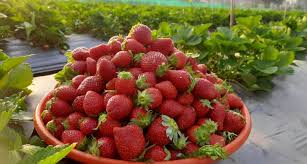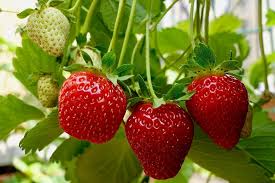Strawberries fruit which is scientifically known as Fragaria × ananassa are delicious red berries that grow on plants. These plants have green leaves and small white flowers. When the flowers turn into strawberries, they become sweet and juicy.
People love to eat strawberries because they taste amazing. They are not only tasty but also healthy. Strawberries are full of vitamins and minerals that are good for our bodies. Eating strawberries can make us feel happy and energized.
You can find strawberries in many places like grocery stores, markets, and even in your own garden if you plant them. They are versatile and can be eaten in different ways. Some people like to eat them fresh, right from the plant. Others prefer to add them to salads or desserts.
Strawberries can be turned into yummy treats like strawberry ice cream, strawberry jam, or strawberry shortcake. These treats are perfect for special occasions or just when you want something sweet.
In the summertime, many people enjoy going strawberry picking. This is when you visit a farm and pick your own strawberries. It’s a fun activity for families, and you get to take home the freshest strawberries.
Apart from being delicious, strawberries have health benefits. They are rich in vitamin C, which helps our immune system. Eating strawberries may also help improve heart health and reduce inflammation in our bodies.
In the world of nature, strawberries play a role in attracting pollinators like bees. The small white flowers on strawberry plants need to be pollinated for the berries to grow. So, strawberries are not only tasty for us but also important for the environment.
Strawberries come in different varieties, each with its own unique taste and appearance. Some are big and juicy, while others are small and sweet. No matter the variety, strawberries are a delightful fruit that brings joy to many people around the world. So, the next time you bite into a strawberry, savor the burst of sweetness and know that you are enjoying a delicious and nutritious treat.
Read Also: Wild Dog Description, their Personality and Care Guide
History of Strawberries (Fragaria × ananassa)

Strawberries have a long and interesting history that dates back centuries. The story of strawberries begins in Europe, where wild strawberries were growing as far back as the Roman times. However, these wild strawberries were much smaller than the plump and juicy ones we know today.
In the 18th century, European farmers began cultivating strawberries to make them larger and more flavorful. During this time, a French engineer named Amédée-François Frézier brought back a unique strawberry species from the Americas. This species, known as the Chilean strawberry, was larger and had a better taste than the European varieties. Farmers started crossbreeding these strawberries with the local ones, leading to the development of the modern cultivated strawberry.
The popularity of strawberries continued to grow, and by the 19th century, they had become a favorite fruit in many parts of Europe and North America. In the United States, commercial strawberry cultivation began in the 19th century, with California becoming a major strawberry-producing state.
Strawberries played a significant role in various cultures and traditions. In medieval times, strawberries were believed to have medicinal properties and were often used to treat various ailments. They were also associated with love and purity, symbolizing perfection and righteousness.
As transportation and refrigeration improved, strawberries became more widely available and enjoyed throughout the year. Today, they are a staple in many households, enjoyed fresh, in jams, desserts, and a variety of culinary creations.
The history of strawberries reflects the journey of a humble wild berry to a globally beloved fruit, highlighting the efforts of farmers, scientists, and enthusiasts who have contributed to the development and popularity of this delightful red berry.
Nutritional Value of Strawberries (Fragaria × ananassa)
Strawberries are not only delicious but also packed with essential nutrients that contribute to a healthy diet. These vibrant red berries are a good source of various vitamins, minerals, and antioxidants.
One of the standout features of strawberries is their high vitamin C content. Vitamin C is known for its role in supporting the immune system and promoting skin health. Eating strawberries can contribute to meeting your daily vitamin C requirements.
Strawberries also contain significant amounts of manganese, which plays a role in bone development and metabolism. They provide dietary fiber, aiding in digestion and promoting a feeling of fullness, which can be beneficial for those looking to manage their weight.
In addition to these, strawberries contain folate, potassium, and antioxidants like quercetin and anthocyanins. Folate is important for cell division, potassium helps regulate blood pressure, and antioxidants play a role in protecting the body from oxidative stress.
These berries are relatively low in calories, making them a nutritious and guilt-free snack. Including strawberries in your diet can contribute to overall health and well-being. It’s worth noting that while strawberries are nutritious, a balanced diet that includes a variety of fruits, vegetables, and other food groups is essential for optimal health.
Furthermore, strawberries are known for their potential health benefits beyond just providing essential nutrients. Studies suggest that the antioxidants found in strawberries may help reduce inflammation in the body, which is linked to various chronic diseases.
The combination of antioxidants, particularly anthocyanins, may contribute to improved heart health by reducing oxidative stress and supporting healthy blood vessel function. Regular consumption of strawberries has been associated with a lower risk of heart-related issues.
Strawberries also contain compounds that may have a positive impact on blood sugar regulation. This can be particularly relevant for individuals managing diabetes or those concerned about blood sugar levels. The fiber content in strawberries may contribute to steady glucose levels and improved insulin sensitivity.
Additionally, the presence of ellagic acid in strawberries has been studied for its potential anti-cancer properties. While research is ongoing, some studies suggest that ellagic acid may help inhibit the growth of certain cancer cells.
Incorporating strawberries into a well-rounded and diverse diet is a flavorful way to enjoy the nutritional benefits they offer. Whether eaten fresh, added to smoothies, or used as a topping for various dishes, strawberries can be a tasty and healthful addition to your meals.
As with any food, moderation is key, and it’s essential to consider individual dietary needs and preferences. Including a variety of fruits and vegetables in your daily intake ensures a broad spectrum of nutrients and contributes to overall health and wellness. So, the next time you indulge in the sweet taste of strawberries, know that you’re not only enjoying a delicious treat but also providing your body with a wealth of nutritional goodness.
Read Also: 15 Amazing Dog Facts you Don’t Know About
Health Benefits of Strawberries (Fragaria × ananassa)

Strawberries come with a range of health benefits, making them a delightful addition to your diet. Here are some notable advantages:
1. Rich in Antioxidants: Strawberries are packed with antioxidants, including vitamin C, quercetin, and anthocyanins. These compounds help combat oxidative stress in the body, potentially reducing the risk of chronic diseases.
2. Heart Health: The antioxidants and fiber in strawberries contribute to heart health. They may help lower blood pressure, reduce inflammation, and improve overall cardiovascular function, lowering the risk of heart-related issues.
3. Blood Sugar Regulation: The fiber content in strawberries, along with their natural sweetness, can aid in regulating blood sugar levels. This can be beneficial for individuals managing diabetes or those looking to maintain steady energy levels.
4. Cancer Prevention: Some studies suggest that the ellagic acid in strawberries may have anti-cancer properties by inhibiting the growth of certain cancer cells. While more research is needed, the potential is promising.
5. Immune System Support: The high vitamin C content in strawberries is known to boost the immune system. Regular consumption may help the body defend itself against infections and illnesses.
6. Eye Health: Strawberries contain antioxidants like lutein and zeaxanthin, which are associated with promoting eye health. These compounds may help protect the eyes from age-related macular degeneration and other vision problems.
7. Anti-Inflammatory Properties: Strawberries have anti-inflammatory effects, which can be beneficial for conditions related to inflammation, such as arthritis. Including strawberries in your diet may contribute to managing inflammation in the body.
8. Weight Management: Despite their natural sweetness, strawberries are relatively low in calories and high in fiber. This combination can contribute to a feeling of fullness, making them a satisfying snack that supports weight management.
Incorporating strawberries into your diet can be a tasty way to reap these health benefits. Whether enjoyed on their own, added to salads, or blended into smoothies, strawberries provide a nutritious and delicious option for promoting overall well-being.
How to Grow Strawberries

Growing strawberries can be a rewarding experience, and they can thrive in various environments. Here’s a simple guide on how to grow strawberries:
1. Choose the Right Variety: Select a strawberry variety that suits your climate and growing conditions. There are three main types: June-bearing, everbearing, and day-neutral. Each has different fruiting patterns.
2. Select a Sunny Location: Plant strawberries in a spot that receives at least 6-8 hours of sunlight per day. Well-drained soil is essential to prevent waterlogging, which can harm the plants.
3. Prepare the Soil: Ensure the soil is rich in organic matter and has good drainage. Add compost or well-rotted manure to improve fertility. Aim for a slightly acidic to neutral pH level.
4. Planting: Plant strawberries in early spring or late summer, depending on your location. Space the plants about 12-18 inches apart in rows, allowing room for runners.
5. Watering: Keep the soil consistently moist, especially during dry periods. Water at the base of the plants to avoid wetting the leaves, as this can lead to disease.
6. Mulching: Apply a layer of straw or pine needles around the plants to suppress weeds, conserve moisture, and keep the fruit clean. This also helps prevent soil-borne diseases.
7. Fertilizing: Fertilize strawberries with a balanced, organic fertilizer when planting and again after the first harvest. Avoid high-nitrogen fertilizers, as they can promote leafy growth at the expense of fruit.
8. Pruning: Remove runners (long stems that grow out from the main plant) to encourage the energy to go into fruit production. Prune dead or yellowing leaves regularly.
9. Protecting from Pests: Keep an eye out for pests like slugs, snails, and birds. Consider using protective netting to prevent birds from eating the ripe berries.
10. Harvesting: Harvest strawberries when they are fully ripe, usually red all over. Pick them carefully to avoid damaging the delicate fruit. Harvest in the morning when it’s cool.
11. Renewal and Replacement: Strawberry plants become less productive after a few years. Consider renewing your strawberry bed by replanting with new, disease-free runners or plants.
By following these steps, you can cultivate a thriving strawberry patch in your garden or even in containers on your balcony. With a little care and attention, you’ll soon be enjoying the sweet taste of homegrown strawberries.
